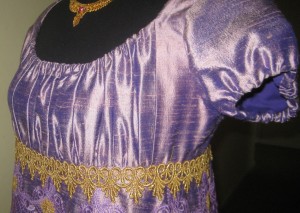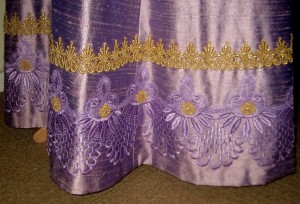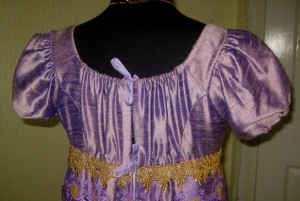I have created a number of gowns for my new talk called ‘Enter the World of Jane Austen’. My new collection of regency inspired costumes includes a beautiful pure lilac silk evening gown trimmed with gold guipure lace. It is worn with matching turban, silk shawl, reticule, necklace and gloves. It can be viewed with a number of my regency Gowns on the right of the picture.
This type of dress would be worn for an important event or soiree so something special was required. For evening wear, light fabrics were still favoured, but they were richer. Very fine muslin, silk satin, duchesse silk and light taffetas were all popular. Braver, older or married women sometimes wore silk velvet. There was an unspoken dress code for debutantes, which applied as much to evening wear as afternoon dress. Young ladies were expected to wear pastels and white. The more sophisticated, darker colours were off-limits to unmarried misses just out of the schoolroom.  Of course, it’s important to remember that dark colours would not show well by candlelight; if one wore black, one would likely disappear! To this end, many dresses utilized metallic trim and glass or crystal beading to catch the light. Short sleeves were often seen in evening dress so long gloves were a necessity.
Of course, it’s important to remember that dark colours would not show well by candlelight; if one wore black, one would likely disappear! To this end, many dresses utilized metallic trim and glass or crystal beading to catch the light. Short sleeves were often seen in evening dress so long gloves were a necessity.
“Jane Austen wrote to her sister, Cassandra, about a ball she attended in 1810. Our ball was rather more amusing than I expected. Martha liked it very much, and I did not gape till the last quarter of an hour. It was past nine before we were sent for and not twelve when we returned. The room was tolerably full, and there were, perhaps, thirty couple of dancers. The melancholy part was, to see so many dozen young ladies standing by without partners, and each of them with two ugly naked shoulders.”
During the years 1815-1820, the fashions had begun to change from the simple, plain muslin dresses of 1800-1810. The sleeves and bodices of dresses became shorter and more elaborately decorated, and to balance this, the bottoms of dresses were also embellished. These embellishments, as well as side gores for the skirt, changed the silhouette of the skirt to be more triangular.
 This ornate lilac ball gown has been created in sumptuous lilac silk and is lined with satin. This makes it hang well and not crease as easily as some silks have a tendency to crease badly particularly dupion silk. A narrow bodice is gathered into a slim line A-line skirt front and side panels, and a full gathered skirt back that falls to full length. On this traditional version, drawstrings fit the bodice firmly to the bust and tie at centre back. The short puffed sleeves can be cut very high or slighter longer – both are authentic. I have used the slightly shorter sleeve on this evening gown as the ball gowns were usually worn with long white cotton gloves which cover above the elbow. As the fabric is quite heavy as it is lined I used a smaller panel for the back of the gown although it is still correct for the period – there are less gathers. I have decorated this beautiful gown with ornate lilac silk guipure trimming on the hem which is echoed below the bust. I have also added a gold guipure lace to add drama. I am sure you’ll agree it adds a luxury feel and style to the gown! The drawstrings below the bust and around the neckline are pretty lilac velvet ribbons.
This ornate lilac ball gown has been created in sumptuous lilac silk and is lined with satin. This makes it hang well and not crease as easily as some silks have a tendency to crease badly particularly dupion silk. A narrow bodice is gathered into a slim line A-line skirt front and side panels, and a full gathered skirt back that falls to full length. On this traditional version, drawstrings fit the bodice firmly to the bust and tie at centre back. The short puffed sleeves can be cut very high or slighter longer – both are authentic. I have used the slightly shorter sleeve on this evening gown as the ball gowns were usually worn with long white cotton gloves which cover above the elbow. As the fabric is quite heavy as it is lined I used a smaller panel for the back of the gown although it is still correct for the period – there are less gathers. I have decorated this beautiful gown with ornate lilac silk guipure trimming on the hem which is echoed below the bust. I have also added a gold guipure lace to add drama. I am sure you’ll agree it adds a luxury feel and style to the gown! The drawstrings below the bust and around the neckline are pretty lilac velvet ribbons.
 Turbans became popular after Napoleon’s invasion of Egypt. They were in an oriental style with nodding ostrich plumes. Jane borrowed a Mameluke cap ‘which was all the fashion now’ in January 1799. It was inspired by the success of nelsons Nile campaign in 1798 and a Nelson hat in velvet was one of the many articles of Nelsoniana worn to commemorate the hero. They were meant to appear exotic. Turbans often included silk and expensive metallic embroidery or brooches. Turbans were really hats. They were sewn into shape, so it’s not as if you had to wind strips of fabric round your head every time you put one on. With the right fabric, a turban could be pretty simple to make. Just wrap and stitch into place
Turbans became popular after Napoleon’s invasion of Egypt. They were in an oriental style with nodding ostrich plumes. Jane borrowed a Mameluke cap ‘which was all the fashion now’ in January 1799. It was inspired by the success of nelsons Nile campaign in 1798 and a Nelson hat in velvet was one of the many articles of Nelsoniana worn to commemorate the hero. They were meant to appear exotic. Turbans often included silk and expensive metallic embroidery or brooches. Turbans were really hats. They were sewn into shape, so it’s not as if you had to wind strips of fabric round your head every time you put one on. With the right fabric, a turban could be pretty simple to make. Just wrap and stitch into place
 The gown is worn with white cotton gloves. White gloves were always worn for formal occasions – above-the-elbow was the preferred length – we often think of gloves as either white or black, but many different colours of kid leather were used, including yellow and blue.
The gown is worn with white cotton gloves. White gloves were always worn for formal occasions – above-the-elbow was the preferred length – we often think of gloves as either white or black, but many different colours of kid leather were used, including yellow and blue.
A fan is worn this would always be carried at a ball. This Battenberg lace fan has wooden spines and is backed with fine gauze. The lace is pretty with panels of delicate embroidery. It is authentic to the period. In the past, hand fans were used not only as cooling instruments, but also as convenient communication devices, mainly for transmitting more or less furtive love messages
With it’s beautiful shimmering fabric, ornate turban, pretty necklace, fan and gloves – I’m sure you’ll agree this fabulous gown is fit for any ball at Netherfield with Mr Darcy!!

